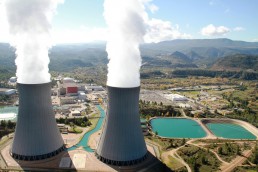- Home
- Environment
- The power station and air
The power station and air
The plant could possibly affect the atmosphere due to the emission of water vapour from the cooling towers and the emission of gaseous radioactive effluents produced during the operation.

The former could affect, theoretically, the microclimate in the area around the plant given the content and temperature of the steam eliminated by the towers. This phenomenon has been discovered through experience accumulated over years of Plant operation.
To get a firmer grasp on the effects of the plant on the local microclimate, mathematical models have been made to study the process that takes place in the towers, evaluating, together with other parameters, the content of water plumes, both in vapor as well as drops.
From the data obtained, studies have been conducted on emissions impact, taking a model that defines the length, height and radius of the possible plumes as a model, relative to the operational situation at the plant and the existing meteorological conditions.
These studies conclude in the prediction of effects of little importance on the local climate, with a slightly average increase in cloud formation in zones close to the Plant, resulting in only a slightly reduced loss of solar radiation.
Similar to the fact that the impact of the towers is independent of the nuclear character of the plant, the second of the possible effects is likewise caused by this fact and is due to the emission into the atmosphere of gaseous radioactive effluents, such as iodine isotopes and noble gases, which are produced when running the installation.
Using the same criteria for liquid discharge, all gaseous effluents are conducted to a single point for subsequent emission to the outside after operations to control radioactivity, through a 75m chimney, to gain a total vigilance and surveillance over gaseous emissions and to improve their atmospheric dispersion.
The total annual activity of radioactive gaseous effluents, above their natural radioactivity, is limited by the corresponding Administrative Authorisation.
These limits make up an insignificant additional contribution vis-à-vis the average annual dosis of natural radioactivity.
